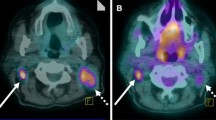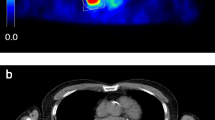Abstract
Fluorine-18 fluorodeoxyglucose positron emission tomography (FDG-PET) has been shown to improve the diagnostic accuracy in the staging of malignant lymphomas, based on the metabolic signal of the lesions. This study was undertaken to determine the effect of attenuation correction in the detection of nodal and extranodal lesions in the primary staging of malignant lymphomas. Fifty-one untreated patients with either non-Hodgkin lymphoma (NHL, n=29) or Hodgkin’s disease (n=22) were retrospectively evaluated. Static FDG-PET imaging of the trunk was performed following administration of 250–350 MBq FDG. Attenuation correction was performed in all patients. Images were reconstructed iteratively with or without transmission scans. Image evaluation was performed independently by two observers, who each examined one set of images (i.e. attenuation-corrected or uncorrected). The final decision as to whether results were discordant was reached by consensus of both observers. Out of 593 evaluated lymph node regions, 187 regions of increased FDG uptake were identified by both techniques. Differences between the readers concerned mainly the anatomical assignment of lesions (n=33) or the status (benign/malignant) of individual lesions (n=24). However, direct comparison of the two sets of images demonstrated very similar lesion contrast on attenuation-corrected and non-attenuation-corrected images. Real differences could be determined only in five regions (neck, 1; mediastinum, 1; upper abdomen, 3). Thirty-seven extranodal lesions (including lung, liver, spleen, bone marrow and soft tissue) were detected by both techniques without significant differences. It is concluded that in this study, attenuation correction did not improve the diagnostic accuracy of FDG-PET in the detection of lymph node or organ involvement during the primary staging of malignant lyphomas. Of more importance seemed to be the experience of the reader regarding the classification of a lesion’s status the anatomical assignment, knowledge of physiological uptake and artefacts, and systematic and skilful examination of all regions scanned.
Similar content being viewed by others
Author information
Authors and Affiliations
Additional information
Received 1 July and in revised form 19 September 1998
Rights and permissions
About this article
Cite this article
Kotzerke, J., Guhlmann, A., Moog, F. et al. Role of attenuation correction for fluorine-18 fluorodeoxyglucose positron emission tomography in the primary staging of malignant lymphoma. Eur J Nucl Med 26, 31–38 (1999). https://doi.org/10.1007/s002590050356
Issue Date:
DOI: https://doi.org/10.1007/s002590050356




